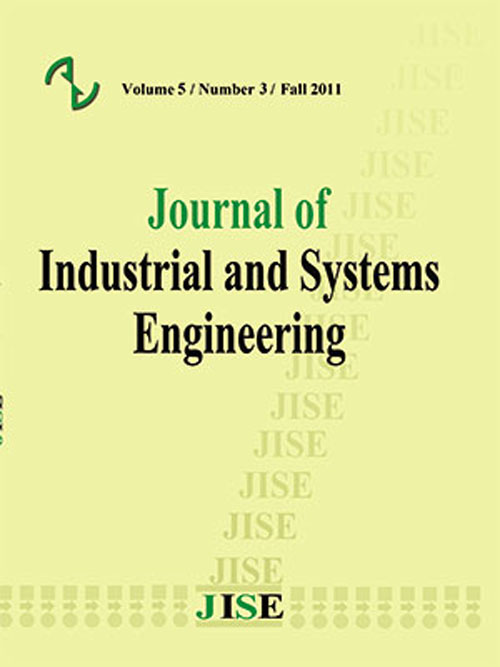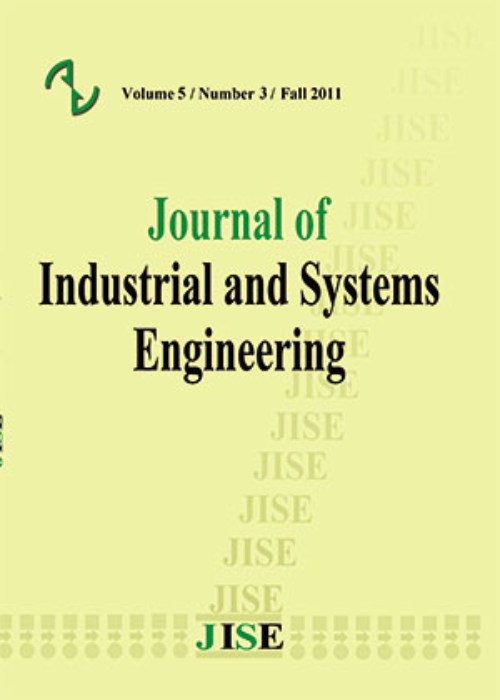فهرست مطالب

Journal of Industrial and Systems Engineering
Volume:10 Issue: 3, Summer 2017
- تاریخ انتشار: 1396/06/30
- تعداد عناوین: 8
-
-
Pages 1-15Planning budget will help to identify wasteful expenditures, adapt financial situation changes quickly, and achieve financial goals. The reliability based budgeting has a great importance for broadcasting industry. In this study, several kinds of failure modes in TV broadcasting system have been detected based on recorded data. The risk priority number is used, for prioritizing the risks that are related to the reliability. We presented a multi-criteria decision making by analytic hierarchy process that has been used for prioritizing the proposed improvement options subject to budget requirement. The results indicate that human factor has more importance in the reliability of the system of TV broadcast that can be improved by education.Keywords: Failure modes, Effects Analysis, Analytic Hierarchy Process, Risk Priority Number, reliability, TV broadcasting system
-
Pages 16-32This paper deals with the determination of machine numbers and production schedules in manufacturing environments. In this line, a two-stage fuzzy stochastic programming model is discussed with fuzzy processing times where both deterioration and learning effects are evaluated simultaneously. The first stage focuses on the type and number of machines in order to minimize the total costs associated with the machine purchase. Based on the made decisions, the second stage aims to schedule orders, while the objective is to minimize total tardiness costs. A dependent-chance programming (DCP) approach is used for the defuzzification of the proposed model. As the resulted formulation is a NP-hard problem, a branch and bound (B&B) algorithm with effective lower bound is developed. Moreover, a genetic algorithm (GA) is proposed to solve problems of large-sizes. The computational results reveal the high efficiency of the proposed methods, in particular the GA, to solve problems of large sizes.Keywords: Scheduling, Design of production systems, Fuzzy methods, Integer programming, learning, Meta-heuristics
-
Pages 33-49Governments and customers are forcing the paper manufacturers to become more sustainable. Accordingly, there still exists a gap in the quantitative modeling of these issues. In this paper, this gap is covered through simultaneously considering economical, environmental and social impacts in the paper closed-loop supply chain network design. The proposed multi-objective, multi-echelon, multi-product and single-period model is composed of suppliers, plants, regional wholesalers, retailers, customer zones, collection sites, centralized collection points, recycling facilities, energy recovery and disposal centers.The objectives considered are minimization of total cost; environmental benefit through maximizing coverage of collected waste paper by opened centralized collection centers; and maximization of the social impact of the network in a way that would prefer the location of facilities in the less populated regions.The proposed model is applied to an illustrative example designed utilizing real data of the paper industry in East Azerbaijan of Iran and interactive fuzzy goal programming approach is used to solve the developed model. Sensitivity analysis of the proposed model is also performed by considering key parameters.Keywords: Closed-loop supply chain, multi-objective programming, location model, paper recovery
-
Pages 50-71This paper develops a pricing and inventory model of a supply chain composing one supplier and two manufacturers in which the supplier sells its product to two competing manufacturers. Each manufacturer faces a deterministic demand that depends on his/her own and the other competitor sale price. Selling price for the supplier is time dependent and increment function.Both amelioration and deterioration effects are seen simultaneously for this model. In this paper, it is assumed that shortages are not allowed in whichthe objective ismaximizing the total profit of supplier and manufacturers in two stages. In first stage, the total profit of supplier is maximized and then in the second stage, two manufacturers maximize their total profits with regard to the optimal decision variables obtained in the first stage. A case study of trout fish breeding is presented andnumerical example is solved by Mathematica optimization tool. Sensitivity analysis is finally conducted to study the effect of various parameters on the optimal solution.Keywords: pricing, inventory model, Deteriorating, ameliorating items, Competing environment, Bertrand game
-
Pages 72-91In this paper an integrated lot-sizing and scheduling problem in a flexible job shop environment with machine-capacity-constraint is studied. The main objective is to minimize the total cost which includes the inventory costs, production costs and the costs of machines idle times. First, a new mixed integer programming model,with small bucket time approach,based onProportional Lot sizing and Scheduling Problems (PLSP), is proposed to formulate the problem. Since the problem under study is NP-hard, a modified harmony search algorithm, with a new built-in local search heuristic is proposed as solution technique.In this algorithm,it is improvised a New Harmony vector in two phases to enhance search ability.Additionally, Taguchi method is used to calibrate the parameters of the modified harmony search algorithm. Finally, comparative results demonstrate the effectiveness of the modified harmony search algorithm in solving the problem.It is also demonstrated that the proposed algorithm can find good quality solutions for all size problems. The objective values obtained by proposed algorithm are better from HS algorithm and exact method results.Keywords: Lot-sizing, Scheduling, flexible job shop, harmony search algorithm
-
Pages 92-112In this paper, a Job shop scheduling problem with a parallel assembly stage and Lot Streaming (LS) is considered for the first time in both machining and assembly stages. Lot Streaming technique is a process of splitting jobs into smaller sub-jobs such that successive operations can be overlapped. Hence, to solve job shop scheduling problem with a parallel assembly stage and lot streaming, decision makers not only need to determine the processing sequences on machines in first stage, but also need to assign each product to a machine and determine the assembly sequences of the products in second stage and the sub-lot sizes of all jobs and products to minimize the makespan. At first, this problem is modeled as a mixed integer linear programming and GAMS software is applied to solve small problems. Since this problem is classified as NP-hard, four hybrid algorithms based on iterative procedures are suggested to solve the problem in medium and large dimensions. In order to verify the effectiveness of the proposed algorithms, a statistical analysis is used along with Relative Percentage Deviation (RPD) factor. Computational results revealed that the hybrid genetic and parallel simulated annealing algorithm (HGAPSA) and the hybrid genetic and parallel variable neighborhood search algorithm (HGAPVNS) perform better than the other proposed algorithms with respect to the objective function. Also, considering lot streaming for both stages instead of applying it only to the first stage leads to achieve better solutions. Finally, the HGAPSA algorithm is compared with a hybrid genetic algorithm (HGA). Experimental results showed that the HGAPSA outperforms the HGA in terms of solution quality.Keywords: Job shop, Parallel Assembly, Lot streaming, HGAPSA, HGAPVNS
-
Pages 113-139From the past, honey has been known as a healthy product for human life. Iran has a suitable climate for beekeeping and is among the high-ranked countries in honey production. However, due to failure to comply with quality issues, export of honey from Iran is associated with many problems. According to this issue, this paper presents a robust possibilistic optimization network design model for honey global supply chain regarding global issues (e.g. Incoterms) and quality problems. The proposed network design model considers the product quality and its effect on the amount of demand. Numerical results from the robust model compared with the deterministic model show that the proposed robust model provides appropriate solutions with low risk for the decision makers.Keywords: Agricultural products, Honey supply chain, Supply chain network design, Robust probabilistic programming
-
Pages 140-160In the current competitive conditions, all the manufacturers efforts are focused on increasing the customer satisfaction as well as reducing the production and delivery costs; thus, there is an increasing concentration on the structure and principles of supply chain (SC). Accordingly, the present research investigated simultaneous optimization of the total costs of a chain and customer satisfaction. The basic innovation of the present research is in the development of the hierarchical location problem of factories and warehouses in a four-level SC with multi-objective approach as well as the use of the multi-objective evolutionary metaheuristic algorithms. The main features of the resulting developed model would include determination of the number and location of the required factories, flow of the raw material from suppliers to factories, determination of the number and location of the distribution centers, flow of the material from factories to distribution centers, and finally allocation of the customers to distribution centers. In order to obtain optimal solutions of the model, a multi-objective hybrid particle swarm algorithm (MOHPSO) was presented; then, to assess performance of the algorithm, its results were compared with those of the NSGA-II algorithm. The numerical results showed that this algorithm had acceptable performance in terms of time and solution quality. On this basis, a real case study was implemented and analyzed for supplying the mountain bikes with the proposed algorithm.Keywords: Location, allocation, multi-level supply chain, non-dominated solution, Pareto optimal solution, hybrid particle swarm algorithm, NSGA-II metaheuristic algorithm


